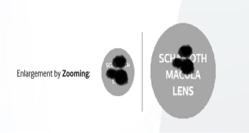Scharioth Macular Lens (SML)
Patients with macular scarring can benefit from Scharioth Macular Lens (SML). The SML technology has been developed to enhance the quality of life of patients with macular scarring due to dry Age Related Macular Degeneration (AMD), stable treated wet Age Related Macular Degeneration (AMD) or other macular diseases like myopic maculopathy and certain hereditary diseases.
Age-related macular degeneration (AMD) is the commonest cause of blind registration in developed countries including UK. It is a disease which effects the central area of the back of eye which is called macula. It causes loss of central vision while your peripheral vision is unaffected. You are not able to see fine details, whether you are looking at something close or far.
Two types of AMD
Dry AMD
This form is the commonest type of AMD. About 80% (8 out of 10) of people who have AMD have the dry form. In this type one loses vision slowly, presently there is no treatment for this type of AMD.
Wet AMD
This form is less common but much more serious. In this type abnormal blood vessels grow under the retina which may leak and bleed causing scarring of the macula. You lose vision faster with wet AMD than with dry AMD.
There have been significant advances in the treatment of wet AMD with the introduction of anti – VEGF ( anti vascular endothelial growth factors) drug injections but even with anti-VEGF treatment a number of patients are left with a macular scar which effects their central vision permanently.
Currently there is no medication available for dry AMD and treatment possibilities are limited to low vision rehabilitation devices (low vision aids and low vision intraocular implants).
Treatment offered for macular scarring (loss of central vision) due to AMD or other retinal conditions
Mr Aftab (Private Eye Surgery- East Division) offers his patients with macular scarring Scharioth Macular Lens (SML). The SML technology has been developed to enhance the quality of life of patients with macular scarring due to dry AMD or stable treated wet AMD. It can also be helpful for patients with other macular diseases, e.g. myopic maculopathy, diabetic retinopathy or certain hereditary retinal diseases.
Mode of Action of Scharioth Macular Lens (SML)
The SML works by causing magnification.
In the illustration below the dark spots (scotomas) covering the text represent damaged macular areas. The SML magnifies the text approximately 2 times but the size of the dark spots remains the same because the SML does not magnify the damaged parts of the macula. Thus, the SML enables patients with macular scarring due to dry AMD (or scarring due to other causes) to read the text.

Advantages of Scharioth Macular Lens (SML)
- All examinations needed for a patient’s regular follow-up after implantation with the SML (retina/macula visualization, OCT etc.) are unaffected.
- All treatments, if needed, can be performed without limitations eg:
– Intravitreal injections in case of exacerbation of maculopathy
– Laser treatment of retina
– YAG laser capsulotomy - Easy and safe surgery
- No visual field reduction
- Unaffected distance vision
- Independent from lens status
- Quick adaptation
- Reversible
- Affordable
Patient talking about Scharioth Macular Lens
Professor Scharioth introducing Scharioth Macular Lens
Surgery animation video
Personalised service
which every individual deserves
Get in touch
Clinic Locations
- Oswald House, 74 Oswald Road
Scunthorpe DN15 7PG
Tel: 01724 413333
- Scunthorpe General Hospital
Scunthorpe DN15 7BH
Tel: 03033 302956
- Diana, Princess of Wales Hospital
Grimsby DN33 2BA
Tel: 03033 302956
- Peaks Lane
Grimsby
DN32 9RP
Tel: 01472 251100
- Goole and District Hospital
Goole DN14 6RX
Tel: 03033 302956
Nuffield Chesterfield Hospital
- Clifton Hill
Bristol BS8 1BN
- Claverton Down Road
Bath BA2 7BR
- Newnham Court Way
Maidstone ME14 5FT
- Chatham
Kent ME5 9PG
